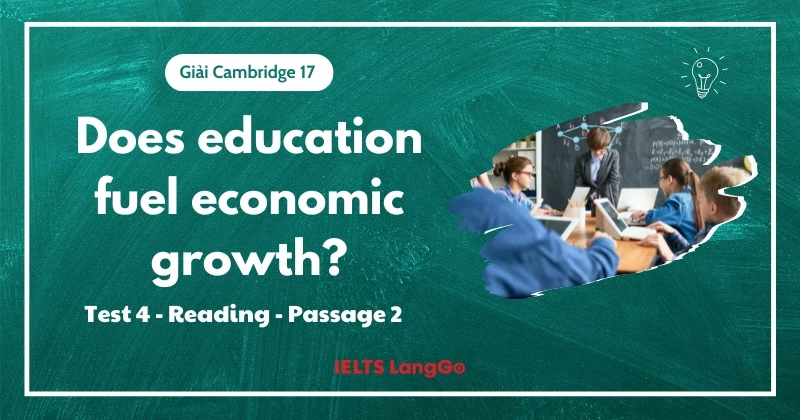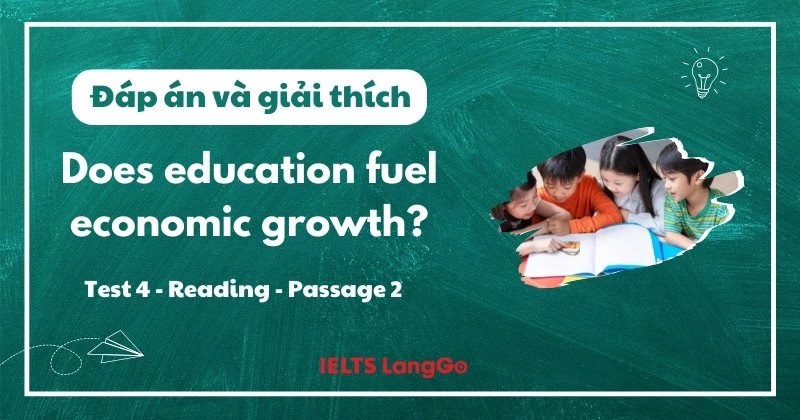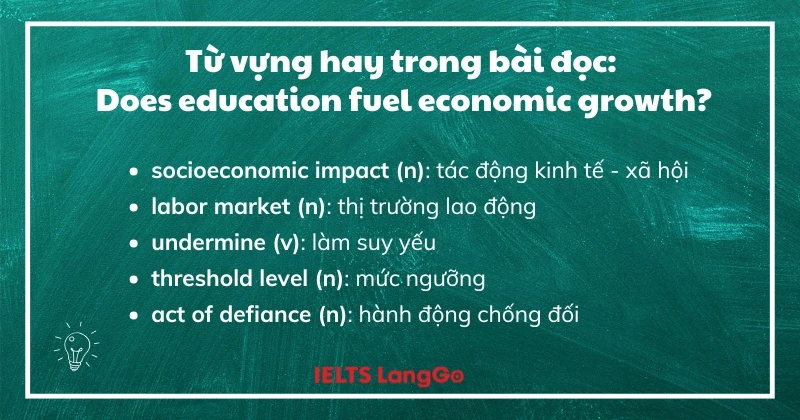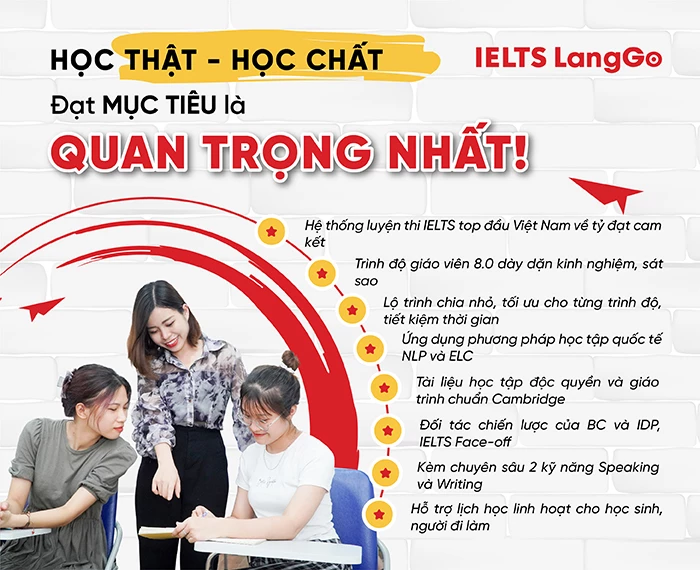



Trong bài viết sau, IELTS LangGo sẽ cung cấp cho các bạn đáp án và giải thích chi tiết của Cam 17, Test 4, Reading passage 2: Does education fuel economic growth? cũng như một số mẹo làm bài giúp bạn luyện đề IELTS Reading hiệu quả hơn. Cùng xem nhé!
Đầu tiên chúng ta hãy cùng xem bài đọc cũng như các câu hỏi nhé:
Does education fuel economic growth?
A
Over the last decade, a huge database about the lives of southwest German villagers between 1600 and 1900 has been compiled by a team led by Professor Sheilagh Ogilvie at Cambridge University’s Faculty of Economics. It includes court records, guild ledgers, parish registers, village censuses, tax lists and – the most recent addition – 9,000 handwritten inventories listing over a million personal possessions belonging to ordinary women and men across three centuries. Ogilvie, who discovered the inventories in the archives of two German communities 30 years ago, believes they may hold the answer to a conundrum that has long puzzled economists: the lack of evidence for a causal link between education and a country’s economic growth.
Trong thập kỷ qua, một cơ sở dữ liệu khổng lồ về cuộc sống của những người dân làng ở miền tây nam nước Đức từ năm 1600 đến 1900 đã được tổng hợp bởi một nhóm nghiên cứu do Giáo sư Sheilagh Ogilvie thuộc Khoa Kinh tế, Đại học Cambridge dẫn đầu. Cơ sở dữ liệu này bao gồm hồ sơ tòa án, sổ ghi chép của các hiệp hội nghề nghiệp, sổ đăng ký giáo xứ, điều tra dân số trong làng, danh sách thuế và – bổ sung mới nhất – 9.000 bản kiểm kê viết tay ghi lại hơn một triệu món đồ cá nhân thuộc sở hữu của những người đàn ông và phụ nữ bình thường qua ba thế kỷ. Ogilvie, người đã phát hiện ra các bản kiểm kê này trong kho lưu trữ của hai cộng đồng ở Đức cách đây 30 năm, tin rằng chúng có thể giải đáp một bí ẩn lâu nay khiến các nhà kinh tế học bối rối: sự thiếu bằng chứng về mối liên hệ nhân quả giữa giáo dục và tăng trưởng kinh tế của một quốc gia.
B
As Ogilvie explains, ‘Education helps us to work more productively, invent better technology, and earn more … surely it must be critical for economic growth? But, if you look back through history, there’s no evidence that having a high literacy rate made a country industrialise earlier.’ Between 1600 and 1900, England had only mediocre literacy rates by European standards, yet its economy grew fast and it was the first country to industrialise. During this period, Germany and Scandinavia had excellent literacy rates, but their economies grew slowly and they industrialised late. ‘Modern cross-country analyses have also struggled to find evidence that education causes economic growth, even though there is plenty of evidence that growth increases education,’ she adds.
Ogilvie giải thích: “Giáo dục giúp chúng ta làm việc hiệu quả hơn, phát minh ra công nghệ tốt hơn và kiếm được nhiều tiền hơn… chắc chắn nó phải là yếu tố quan trọng đối với tăng trưởng kinh tế? Nhưng nếu nhìn lại lịch sử, không có bằng chứng nào cho thấy tỷ lệ biết chữ cao giúp một quốc gia công nghiệp hóa sớm hơn.” Từ năm 1600 đến 1900, Anh chỉ có tỷ lệ biết chữ trung bình so với mặt bằng chung ở châu Âu, nhưng nền kinh tế của họ lại phát triển nhanh chóng và trở thành quốc gia đầu tiên công nghiệp hóa. Trong khi đó, Đức và các nước Scandinavia có tỷ lệ biết chữ rất cao nhưng nền kinh tế phát triển chậm và công nghiệp hóa muộn. “Các phân tích hiện đại giữa các quốc gia cũng gặp khó khăn trong việc tìm ra bằng chứng cho thấy giáo dục dẫn đến tăng trưởng kinh tế, mặc dù có rất nhiều bằng chứng rằng tăng trưởng kinh tế lại làm tăng mức độ giáo dục,” bà nói thêm.
C
In the handwritten inventories that Ogilvie is analyzing are the belongings of women and men at marriage, remarriage and death. From badger skins to Bibles, sewing machines to scarlet bodices – the villagers’ entire worldly goods are included. Inventories of agricultural equipment and craft tools reveal economic activities; ownership of books and education related objects like pens and slates suggests how people learned. In addition, the tax lists included in the database record the value of farms, workshops, assets and debts; signatures and people’s estimates of their age indicate literacy and numeracy levels; and court records reveal obstacles (such as the activities of the guilds) that stifled industry.
Những bản kiểm kê viết tay mà Ogilvie đang phân tích ghi lại tài sản của nam giới và phụ nữ vào thời điểm kết hôn, tái hôn và qua đời. Từ da lửng đến Kinh Thánh, từ máy may đến áo nịt màu đỏ thẫm – toàn bộ tài sản của người dân làng đều được liệt kê. Các bản kiểm kê về thiết bị nông nghiệp và công cụ thủ công cho thấy các hoạt động kinh tế, trong khi việc sở hữu sách và các vật dụng liên quan đến giáo dục như bút và bảng đá gợi ý cách mà mọi người học tập. Ngoài ra, danh sách thuế trong cơ sở dữ liệu ghi lại giá trị của trang trại, xưởng làm việc, tài sản và khoản nợ; chữ ký và ước tính độ tuổi của mọi người thể hiện mức độ biết đọc, biết viết và khả năng tính toán; hồ sơ tòa án tiết lộ các rào cản (chẳng hạn như hoạt động của các hiệp hội nghề nghiệp) đã cản trở sự phát triển của nền công nghiệp.
Previous studies usually had just one way of linking education with economic growth – the presence of schools and printing presses, perhaps, or school enrolment, or the ability to sign names. According to Ogilvie, the database provides multiple indicators for the same individuals, making it possible to analyze links between literacy, numeracy, wealth, and industriousness, for individual women and men over the long term.
Những nghiên cứu trước đây thường chỉ có một cách để liên kết giáo dục với tăng trưởng kinh tế – có thể là dựa vào sự xuất hiện của trường học và nhà in, hoặc tỷ lệ nhập học, hoặc khả năng ký tên. Theo Ogilvie, cơ sở dữ liệu này cung cấp nhiều chỉ số khác nhau về cùng một cá nhân, giúp phân tích được mối liên hệ giữa mức độ biết chữ, khả năng tính toán, tài sản và sự chăm chỉ của từng người trong suốt thời gian dài.
D
Ogilvie and her team have been building the vast database of material possessions on top of their full demographic reconstruction of the people who lived in these two German communities. ‘We can follow the same people – and their descendants – across 300 years of educational and economic change,’ she says. Individual lives have unfolded before their eyes. Stories like that of the 24-year-olds Ana Regina and Magdalena Riethmüllerin, who were chastised in 1707 for reading books in church instead of listening to the sermon. ‘This tells us they were continuing to develop their reading skills at least a decade after leaving school,’ explains Ogilvie. The database also reveals the case of Juliana Schweickherdt, a 50-year-old spinster living in the small Black Forest community of Wildberg, who was reprimanded in 1752 by the local weavers’ guild for ‘weaving cloth and combing wool, counter to the guild ordinance’. When Juliana continued taking jobs reserved for male guild members, she was summoned before the guild court and told to pay a fine equivalent to one third of a servant’s annual wage. It was a small act of defiance by today’s standards, but it reflects a time when laws in Germany and elsewhere regulated people’s access to labor markets. The dominance of guilds not only prevented people from using their skills, but also held back even the simplest industrial innovation.
Ogilvie và nhóm của bà đã xây dựng cơ sở dữ liệu khổng lồ về tài sản cá nhân trên nền tảng của một bản tái dựng đầy đủ về nhân khẩu học của những người sống trong hai cộng đồng Đức này. “Chúng tôi có thể theo dõi cùng một người – và cả con cháu của họ – trong suốt 300 năm thay đổi về giáo dục và kinh tế,” bà nói. Những cuộc đời cá nhân dần hiện ra trước mắt các nhà nghiên cứu. Chẳng hạn, câu chuyện của hai cô gái 24 tuổi Ana Regina và Magdalena Riethmüllerin, những người bị khiển trách vào năm 1707 vì đọc sách trong nhà thờ thay vì lắng nghe bài giảng. “Điều này cho thấy họ vẫn tiếp tục phát triển kỹ năng đọc ít nhất một thập kỷ sau khi rời trường,” Ogilvie giải thích. Cơ sở dữ liệu cũng hé lộ trường hợp của Juliana Schweickherdt, một phụ nữ độc thân 50 tuổi sống trong cộng đồng nhỏ Wildberg ở vùng rừng Đen. Năm 1752, bà bị hiệp hội thợ dệt địa phương khiển trách vì “dệt vải và chải len trái với quy định của hiệp hội”. Khi Juliana tiếp tục nhận những công việc vốn chỉ dành cho nam giới trong hiệp hội, bà bị triệu tập trước tòa án của hiệp hội và bị phạt một khoản tiền tương đương với một phần ba tiền lương hàng năm của một người hầu. Dù chỉ là một hành động phản kháng nhỏ theo tiêu chuẩn ngày nay, nhưng nó phản ánh một thời kỳ mà luật pháp ở Đức và nhiều nơi khác hạn chế cơ hội tham gia thị trường lao động của người dân. Quyền lực của các hiệp hội nghề nghiệp không chỉ ngăn cản mọi người tận dụng kỹ năng của mình mà còn kìm hãm cả những đổi mới công nghiệp đơn giản nhất.
E
The data-gathering phase of the project has been completed and now, according to Ogilvie, it is time ‘to ask the big questions’. One way to look at whether education causes economic growth is to ‘hold wealth constant’. This involves following the lives of different people with the same level of wealth over a period of time. If wealth is constant, it is possible to discover whether education was, for example, linked to the cultivation of new crops, or to the adoption of industrial innovations like sewing machines. The team will also ask what aspect of education helped people engage more with productive and innovative activities. Was it, for instance, literacy, numeracy, book ownership, years of schooling? Was there a threshold level – a tipping point – that needed to be reached to affect economic performance?
Giai đoạn thu thập dữ liệu của dự án đã hoàn tất và bây giờ, theo Ogilvie, đã đến lúc "đặt ra những câu hỏi lớn”. Một cách để kiểm tra liệu giáo dục có thực sự thúc đẩy tăng trưởng kinh tế hay không là “giữ mức tài sản không đổi”. Điều này có nghĩa là theo dõi cuộc sống của những người có cùng mức tài sản trong một khoảng thời gian nhất định. Nếu tài sản được giữ nguyên, thì có thể xác định liệu giáo dục có liên quan đến việc trồng trọt các loại cây mới hay việc áp dụng các đổi mới công nghiệp như máy may hay không. Nhóm nghiên cứu cũng sẽ đặt câu hỏi yếu tố nào của giáo dục giúp mọi người tham gia nhiều hơn vào các hoạt động sản xuất và đổi mới. Liệu đó có phải là khả năng đọc viết, tính toán, sở hữu sách hay số năm đi học? Có phải cần đạt đến một mức độ nhất định – một "điểm bùng phát" – để giáo dục có thể ảnh hưởng đến hiệu suất kinh tế?
F
Ogilvie hopes to start finding answers to these questions over the next few years. One thing is already clear, she says: the relationship between education and economic growth is far from straightforward. ‘German-speaking central Europe is an excellent laboratory for testing theories of economic growth,’ she explains. Between 1600 and 1900, literacy rates and book ownership were high and yet the region remained poor. It was also the case that local guilds and merchant associations were extremely powerful and legislated against anything that undermined their monopolies. In villages throughout the region, guilds blocked labor migration and resisted changes that might reduce their influence.
Ogilvie hy vọng sẽ tìm ra câu trả lời cho những câu hỏi này trong vài năm tới. Tuy nhiên, một điều đã rõ ràng, bà nói: mối quan hệ giữa giáo dục và tăng trưởng kinh tế không hề đơn giản. “Trung Âu nói tiếng Đức là một phòng thí nghiệm tuyệt vời để kiểm nghiệm các lý thuyết về tăng trưởng kinh tế,” bà giải thích. Từ năm 1600 đến 1900, tỷ lệ biết chữ và số lượng sách sở hữu tại khu vực này rất cao, nhưng nền kinh tế vẫn nghèo nàn. Điều quan trọng là các hiệp hội nghề nghiệp và liên minh thương nhân ở đây có quyền lực cực kỳ lớn, và họ đặt ra những quy định nhằm bảo vệ sự độc quyền của mình. Ở nhiều ngôi làng trong khu vực, các hiệp hội này ngăn cản di cư lao động và phản đối những thay đổi có thể làm suy yếu vị thế của họ.
‘Early findings suggest that the potential benefits of education for the economy can be held back by other barriers, and this has implications for today,’ says Ogilvie. ‘Huge amounts are spent improving education in developing countries, but this spending can fail to deliver economic growth if restrictions block people – especially women and the poor – from using their education in economically productive ways. If economic institutions are poorly set up, for instance, education can’t lead to growth.’
“Những phát hiện ban đầu cho thấy những lợi ích tiềm năng của giáo dục đối với nền kinh tế có thể bị kìm hãm bởi các rào cản khác, và điều này có ý nghĩa đối với thế giới ngày nay,” Ogilvie nhận xét. “Hàng tỷ đô la đang được đầu tư để cải thiện giáo dục ở các nước đang phát triển, nhưng khoản đầu tư này có thể không mang lại tăng trưởng kinh tế nếu có những rào cản ngăn cản con người – đặc biệt là phụ nữ và người nghèo – sử dụng giáo dục của họ vào những hoạt động kinh tế hiệu quả. Nếu các thể chế kinh tế được thiết lập kém, giáo dục cũng không thể thúc đẩy tăng trưởng.”
Questions 14-18
Reading Passage 2 has six sections, A-F.
Which section contains the following information?
Write the correct letter, A-F, in boxes 14-18 on your answer sheet.
14. an explanation of the need for research to focus on individuals with a fairly consistent income
15. examples of the sources the database has been compiled from
16. an account of one individual’s refusal to obey an order
17. a reference to a region being particularly suited to research into the link between education and economic growth
18. examples of the items included in a list of personal possessions
Questions 19-22
Complete the summary below.
Choose ONE WORD from the passage for each answer.
Write your answers in boxes 19-22 on your answer sheet
| Demographic reconstruction of two German communities The database that Ogilvie and her team has compiled sheds light on the lives of a range of individuals, as well as those of their 19 _____, over a 300-year period. For example, Ana Regina and Magdalena Riethmüllerin were reprimanded for reading while they should have been paying attention to a 20 _____. There was also Juliana Schweickherdt, who came to the notice of the weavers’ guild in the year 1752 for breaking guild rules. As a punishment, she was later given a 21 _____. Cases like this illustrate how the guilds could prevent 22 _____ and stop skilled people from working. |
Questions 23-24
Choose TWO letters, A-E.
Write your answers in boxes 23 and 24 on your answer sheet.
Which TWO of the following statements does the writer make about literacy rates in Section B?
A. Very little research has been done into the link between high literacy rates and improved earnings.
B. Literacy rates in Germany between 1600 and 1900 were very good.
C. There is strong evidence that high literacy rates in the modern world result in economic growth.
D. England is a good example of how high literacy rates helped a country industrialise.
E. Economic growth can help to improve literacy rates.
Questions 25-26
Choose TWO letters, A-E.
Write your answers in boxes 25 and 26 on your answer sheet.
Which TWO of the following statements does the writer make in Section F about guilds in German-speaking Central Europe between 1600 and 1900?
A. They helped young people to learn a skill.
B. They were opposed to people moving to an area for work.
C. They kept better records than guilds in other parts of the world.
D. They opposed practices that threatened their control over a trade.
E. They predominantly consisted of wealthy merchants.
Phân tích đề và chiến lược làm bài:
Ở Passage này có 3 dạng câu hỏi chia thành 13 câu hỏi. Hãy cùng phân tích chiến lược làm bài của các dạng câu hỏi này nhé:

Dạng 1: Matching information
Dạng 2: Summary completion
Dạng 3: Pick from a list
Đây là đáp án của các câu hỏi trong passage này:
| Answer | |
| 14. E | 21. fine |
| 15. A | 22. innovation |
| 16. D | 23. B |
| 17. F | 24. E |
| 18. C | 25. B |
| 19. descendants | 26. D |
| 20. sermon |
|
Hãy đọc kỹ phần giải thích dưới đây để học thêm cả những cách đề bài paraphrase thông tin quan trọng nữa nhé.
Đáp án: E
Vị trí: Đoạn E
Keywords câu hỏi: an explanation of the need for research to focus on individuals with a fairly consistent income
Keywords trong bài đọc: This involves following the lives of different people with the same level of wealth over a period of time. If wealth is constant, it is possible to discover whether education was, for example, linked to the cultivation of new crops, or to the adoption of industrial innovations like sewing machines.
Giải thích: Câu hỏi hỏi về một sự giải thích về nhu cầu cho việc nghiên cứu tập trung vào những cá nhân có thu nhận khá ổn định mà trong đoạn E nói rằng: “Điều này có nghĩa là theo dõi cuộc sống của những người có cùng mức tài sản trong một khoảng thời gian nhất định. Nếu tài sản được giữ nguyên, thì có thể xác định liệu giáo dục có liên quan đến việc trồng trọt các loại cây mới hay việc áp dụng các đổi mới công nghiệp như máy may hay không.”
Đáp án: A
Vị trí: Đoạn A
Keywords câu hỏi: examples of the sources the database has been compiled from
Keywords trong bài đọc: Over the last decade, a huge database about the lives of southwest German villagers between 1600 and 1900 has been compiled by a team led by Professor Sheilagh Ogilvie at Cambridge University’s Faculty of Economics. It includes court records, guild ledgers, parish registers, village censuses, tax lists [...]
Từ loại: danh từ
Giải thích: Câu hỏi hỏi về những ví dụ về những nguồn mà cơ sở dữ liệu được biên soạn mà trong đoạn A lại nói: “Trong thập kỷ qua, một cơ sở dữ liệu khổng lồ về cuộc sống của những người dân làng ở miền tây nam nước Đức từ năm 1600 đến 1900 đã được tổng hợp bởi một nhóm nghiên cứu do Giáo sư Sheilagh Ogilvie thuộc Khoa Kinh tế, Đại học Cambridge dẫn đầu. Cơ sở dữ liệu này bao gồm hồ sơ tòa án, sổ ghi chép của các hiệp hội nghề nghiệp, sổ đăng ký giáo xứ, điều tra dân số trong làng, danh sách thuế.”
Đáp án: D
Vị trí: Đoạn D
Keywords câu hỏi: an account of one individual’s refusal to obey an order
Keywords trong bài đọc: The database also reveals the case of Juliana Schweickherdt, a 50-year-old spinster living in the small Black Forest community of Wildberg, who was reprimanded in 1752 by the local weavers’ guild for ‘weaving cloth and combing wool, counter to the guild ordinance’.
Giải thích: Câu hỏi hỏi về một ví dụ một người từ chối tuân theo quy định mà trong đoạn D lại nói: “Cơ sở dữ liệu cũng hé lộ trường hợp của Juliana Schweickherdt, một phụ nữ độc thân 50 tuổi sống trong cộng đồng nhỏ Wildberg ở vùng rừng Đen. Năm 1752, bà bị hiệp hội thợ dệt địa phương khiển trách vì “dệt vải và chải len trái với quy định của hiệp hội”.”
Đáp án: F
Vị trí: Đoạn F
Keywords câu hỏi: a reference to a region being particularly suited to research into the link between education and economic growth
Keywords trong bài đọc: The relationship between education and economic growth is far from straightforward. ‘German-speaking central Europe is an excellent laboratory for testing theories of economic growth,’
Giải thích: Câu hỏi hỏi về một khu vực phù hợp với nghiên cứu về liên kết giữa giáo dục và phát triển kinh tế, mà trong đoạn F lại nói rằng: “mối quan hệ giữa giáo dục và tăng trưởng kinh tế không hề đơn giản. “Trung Âu nói tiếng Đức là một phòng thí nghiệm tuyệt vời để kiểm nghiệm các lý thuyết về tăng trưởng kinh tế,”
Đáp án: C
Vị trí: Đoạn C
Keywords câu hỏi: examples of the items included in a list of personal possessions
Keywords trong bài đọc: In the handwritten inventories that Ogilvie is analyzing are the belongings of women and men at marriage, remarriage and death. From badger skins to Bibles, sewing machines to scarlet bodices – the villagers’ entire worldly goods are included. Inventories of agricultural equipment and craft tools reveal economic activities; ownership of books and education related objects like pens and slates suggests how people learned.
Giải thích: Câu hỏi hỏi về những ví dụ của những đồ vật có trong danh sách những vật thuộc sở hữu cá nhân mà đoạn C lại nói: “Những bản kiểm kê viết tay mà Ogilvie đang phân tích ghi lại tài sản của nam giới và phụ nữ vào thời điểm kết hôn, tái hôn và qua đời. Từ da lửng đến Kinh Thánh, từ máy may đến áo nịt màu đỏ thẫm – toàn bộ tài sản của người dân làng đều được liệt kê. Các bản kiểm kê về thiết bị nông nghiệp và công cụ thủ công cho thấy các hoạt động kinh tế, trong khi việc sở hữu sách và các vật dụng liên quan đến giáo dục như bút và bảng đá gợi ý cách mà mọi người học tập.”

Đáp án: descendants
Vị trí: Đoạn D
Keywords câu hỏi: The database that Ogilvie and her team has compiled sheds light on the lives of a range of individuals, as well as those of their 19 _____, over a 300-year period.
Keywords trong bài đọc: Ogilvie and her team have been building the vast database of material possessions on top of their full demographic reconstruction of the people who lived in these two German communities. ‘We can follow the same people – and their descendants – across 300 years of educational and economic change,’ she says.
Từ loại: danh từ
Giải thích: Trong câu hỏi nói rằng cơ sở dữ liệu mà Ogilvie và nhóm của cô ấy đã biên soạn làm sáng tỏ cuộc sống của nhiều người cũng như ai đó của họ trong suốt 300 năm nên từ cần điền ở đây là descendants - con cháu.
Đáp án: sermon
Vị trí: Đoạn D
Keywords câu hỏi: For example, Ana Regina and Magdalena Riethmüllerin were reprimanded for reading while they should have been paying attention to a 20 _____.
Keywords trong bài đọc: Stories like that of the 24-year-olds Ana Regina and Magdalena Riethmüllerin, who were chastised in 1707 for reading books in church instead of listening to the sermon.
Từ loại: danh từ
Giải thích: Trong câu hỏi nói rằng Ana Regina và Magdalena Riethmüllerin bị phạt vì đọc sách trong khi đáng lẽ họ nên chú ý vào cái gì đó, nên từ cần điền ở đây là sermon - bài thuyết giáo.
Đáp án: fine
Vị trí: Đoạn D
Keywords câu hỏi: There was also Juliana Schweickherdt, who came to the notice of the weavers’ guild in the year 1752 for breaking guild rules. As a punishment, she was later given a 21 _____.
Keywords trong bài đọc: The database also reveals the case of Juliana Schweickherdt, a 50-year-old spinster living in the small Black Forest community of Wildberg, who was reprimanded in 1752 by the local weavers’ guild for ‘weaving cloth and combing wool, counter to the guild ordinance’. When Juliana continued taking jobs reserved for male guild members, she was summoned before the guild court and told to pay a fine equivalent to one third of a servant’s annual wage.
Từ loại: danh từ
Giải thích: Trong câu hỏi nói rằng cũng có Juliana, người đã bị hội thợ dệt chú ý vào năm 1752 vì vi phạm quy tắc của hội và như một hình phạt, sau đó cô đã bị nhận cái gì đó, nên từ cần điền ở đây là fine - sự phạt tiền.
Đáp án: innovation
Vị trí: Đoạn D
Keywords câu hỏi: Cases like this illustrate how the guilds could prevent 22 _____ and stop skilled people from working.
Keywords trong bài đọc: The dominance of guilds not only prevented people from using their skills, but also held back even the simplest industrial innovation.
Từ loại: danh từ
Giải thích: Trong câu hỏi nói rằng những trường hợp như thế phản ánh cách những hiệp hội có thể ngăn chặn điều gì đó và khiến những người có kỹ năng không được làm việc nên từ cần điền ở đây là innovation - sự đổi mới.
Đáp án: B & E
Vị trí: Đoạn B
Keywords câu hỏi: Which TWO of the following statements does the writer make about literacy rates in Section B?
A. Very little research has been done into the link between high literacy rates and improved earnings.
B. Literacy rates in Germany between 1600 and 1900 were very good.
C. There is strong evidence that high literacy rates in the modern world result in economic growth.
D. England is a good example of how high literacy rates helped a country industrialise.
E. Economic growth can help to improve literacy rates.
Keywords trong bài đọc: Between 1600 and 1900, England had only mediocre literacy rates by European standards, yet its economy grew fast and it was the first country to industrialise. During this period, Germany and Scandinavia had excellent literacy rates, but their economies grew slowly and they industrialised late. ‘Modern cross-country analyses have also struggled to find evidence that education causes economic growth, even though there is plenty of evidence that growth increases education,’
Giải thích: Đáp án B nói rằng tỷ lệ biết đọc viết ở Mỹ giữa năm 1600 và 1900 rất tốt và đáp án E nói rằng phát triển kinh tế có thể giúp nâng cao tỷ lệ biết đọc viết mà trong bài có những thông tin này nên ta chọn.
Đáp án: B & D
Vị trí: Đoạn F
Keywords câu hỏi: Which TWO of the following statements does the writer make in Section F about guilds in German-speaking Central Europe between 1600 and 1900?
A. They helped young people to learn a skill.
B. They were opposed to people moving to an area for work.
C. They kept better records than guilds in other parts of the world.
D. They opposed practices that threatened their control over a trade.
E. They predominantly consisted of wealthy merchants.
Keywords trong bài đọc: ‘German-speaking central Europe is an excellent laboratory for testing theories of economic growth,’ she explains. Between 1600 and 1900, literacy rates and book ownership were high and yet the region remained poor. It was also the case that local guilds and merchant associations were extremely powerful and legislated against anything that undermined their monopolies. In villages throughout the region, guilds blocked labor migration and resisted changes that might reduce their influence.
Giải thích: Đáp án B nói rằng những hiệp hội này phản đối việc mọi người di chuyển đến nơi khác để làm việc và đáp án D nói rằng họ phản đối những chính sách mà có thể đe dọa đến sự kiểm soát của họ đối với thương mại mà trong bài có những thông tin này nên ta chọn.
Sau khi đã chữa kỹ và hiểu tại sao mình lại sai thì bước tiếp theo các bạn nên làm là đọc lại bài và có thể tự tóm tắt nội dung của bài để chắc chắn là mình hiểu. Từ đây các bạn cũng có thể rút ra một số ý tưởng và từ vựng và cấu trúc ngữ pháp để áp dụng vào bài Writing hoặc Speaking của mình nhé.
IELTS LangGo sẽ giúp các bạn lọc ra một số từ vựng hữu ích từ bài đọc này:

personal possession (n): tài sản cá nhân
archive (n): kho lưu trữ
conundrum (n): câu đố hóc búa
mediocre (adj): trung bình, không nổi bật
cross-country (adj): giữa các quốc gia
worldly good (n): tài sản vật chất
stifle (v): kìm hãm
chastise (v): trách mắng
equivalent to (phr.): tương đương
hold back (phr.): kìm hãm
economic inequality (n): bất bình đẳng kinh tế
socioeconomic impact (n): tác động kinh tế - xã hội
labor market (n): thị trường lao động
undermine (v): làm suy yếu
threshold level (n): mức ngưỡng
act of defiance (n): hành động chống đối
Trên đây là phần giải đề Cam 17, Test 4, Reading passage 2: Does education fuel economic growth?. Bạn hãy chữa bài kỹ và hiểu rõ vì sao mình làm sai, đồng thời học thêm các mẹo làm bài và từ vựng hay để rút kinh nghiệm cho lần làm bài sắp tới nhé!



ĐẶT LỊCH TƯ VẤN MIỄN PHÍ LỘ TRÌNH Săn ƯU ĐÃI lên tới 12.000.000đ